Thomas-Chaloner Bisse-Challoner
Thomas-Chaloner Bisse-Challoner[Note 1] DL, JP (1788–1872) was a British militia colonel who enlarged the former country house and landscape garden in 600 acres (2.4 km2) at Portnall Park, Virginia Water, then considered Egham Heath, sitting on the Bagshot Formation.[1] This laid the foundation for the Wentworth Estate and many of the opulent houses of the sparesly populated area, alongside its proximity to Windsor and Windsor Great Park as the British royal family's wealth and connections expanded enabling them to set up nearby grand homes. He inherited much of his fortune principally via his great-aunt Lydia Challoner and cousin Valentina Aynscombe.
Thomas-Chaloner Bisse-Challoner | |
|---|---|
_by_Spiridone_Giambardella.jpg) | |
| Born | 11 December 1788 |
| Died | 26 July 1872 (aged 83) |
| Nationality | British |
| Occupation | Militia Colonel and Magistrate |
Ancestry, early life, education and family life
Colonel Challoner was the only son of the Rev. Thomas Bisse (c.1754-d.13 November 1828), of Portnall Park, Virginia Water and Katherine Townsend (d.1815/16) daughter of Anne Smith, a daughter of merchant Robert Smith, of London and Mortlake.
He was educated at Eton College (c1802-1805) and Trinity College, Oxford.[Note 2]
Father
His father, the Rev. Thomas Bisse, armigerous according to Oxford, attended Wadham College from 1 July 1772,[2] aged 18, and been awarded a BA, 19 April 1776, Battels Christmas 1783, and MA, 22 May 1783. Appointed curate at Kingswear, Exeter in 1784. Rev. Thomas Bisse was the son Thomas Bisse of London (Thomae Bisse de Civ. Londin:), (‘’a gent.’’, again according to Oxford University), possibly the Rev. Thomas Bisse, A.M., chaplain of New College (and All Souls) 1729 and 1732, a nephew or son of the Rev. Dr. Thomas Bisse (1675–1731) preacher at the Rolls Chapel, London, author of The Beauties of Holiness, 1716 and prebend then chancellor of Hereford, and hence was also nephew or son of Philip Bisse, FRS (elected 13 June 1706), Bishop of Hereford.
However, his father is more likely to have been Thomas Bisse (d.1766) Drawing master of Christ's Hospital from 1754 to 1766, successor to Alexander Cozens, who mentions a son Thomas, a brother William, niece Joan, and late wife Susanna in his will.[3] (Bernard Lens II was also a Christ's Hospital Drawing Master).
Dr. and Bishop Bisse were sons of Rev. John Bisse, Rector of Oldbury from 1659/60, co. Gloucester (c1638-d.1686, buried 19 July), who had matriculated Wadham College 28 March 1655. He was son of Thomas Bisse of Lullington, Somerset, and grandson of Thomas Bisse, and great-grandson of Dr. Phillip Bisse (c.1540 – October 1613) who had been Fellow of Magdalen College, Oxford 1561–65, Archdeacon of Taunton, a benefactor of All Souls and had made the inaugural gift of 2,000 books to Wadham College Library. Their mother, Joyce Giles, died 8 September 1717, aged 80 (Historical Register Chronicle 1714–1738), via Musgrave).
A cousin, Philip Bisse (c.1611–1642, killed by Irish), a grandson of Dr. Philip Bisse, the Wadham benefactor, was Archdeacon of Cloyne, and possibly he for whom the Bisse arms were registered in Ireland, 25 May 1637.
Half-brother
William Chaloner Bisse (1822–1849) was the Rev. Thomas Bisse's son by his second wife, Charlotte, whom he married in 1818, a daughter of Charles Price of Knightsbridge. His aunt Elizabeth Price married 24 June 1799 Jonathan Raine (1763–1831), of Lincoln's Inn and 33 Bedford Row, KC, a Yorkshire born, sometime MP for various Cornish constituencies, and eventually a Welsh judge. Charlotte was left £1,000 per annum, as fixed by my marriage settlement when Thomas Bisse died in 1828. At the same time William was left five shares in the Stafford and Worcester Canal.
He became an Ensign in the 73rd Regiment of Foot on 12 March 1841; was promoted to Lieutenant on 5 April 1844; and to Captain on 12 May 1848. However, he died in Ireland on 8 June 1849 aged 27 and lies buried at Templemore in Tipperary, where his 'brother officers' erected a marble tablet in the chancel of the New Church.
Family tree
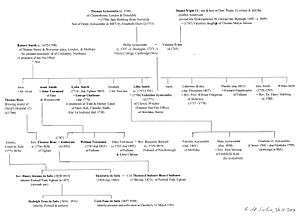
Challoner's maternal great–grandfather Robert Smith (c. 1672–1748), a freeman of London, of Thames Street, London and Mortlake, was the common ancestor.
Smith had ten children:
- Alice who married Mr. Owirk.
- Ann(e) who married John Townsend, had:
- William of Fulham House (1741–1823)[4][5]
- Mary Barnard, d. Little Chelsea (16 April 1842, aged 90), widow of Prebend of Peterborough)
- Katherine Bisse (died 1816), had:
- Thomas-Chaloner Bisse(-Chaloner)
- Lydia (1714–1803), married Thomas Waters (died 1738), then George Challoner (died 1770) of Hales Hall,[6] Cheadle, Staffordshire. Later she was of Tite Hill, Egham.[7]
- Elizabeth who married Joseph Pouschon;
- Lillie Aynscombe (c. 1715 – 1791, buried Clewer, Berkshire) – by Private Act of Parliament of 1747 he changed his surname.[8] He was a director of the Sun Fire Office from, at latest, 1754 until his death in 1791. He married Valentina Aynscombe (died 1771, buried Clewer) most direct descendant and beneficiary of Thomas Aynscombe (died 1740) of Charterhouse Square. Her father Philip Aynscombe (died Boulogne 1737) had married Valentina (died 1745), of St. George, Hanover Square, daughter and heir of Daniel Wight III of Southwark.
- Sarah;
- Catherine (Miss Kitty Smith) (died Brompton 1807), married 31 March 1758, Rev. William Fraigneau (1717–1778). Fraigneau was fellow of Trinity College, Cambridge, tutor to family of Frederick, Lord Bolingbroke and Rector of Beckenham (1765–1778), Kent and Vicar of Battersea (1758–1778). Cambridge's Regius Professor of Greek 1744–1750;
- Phoebe (died Fulham, 29 March 1821)[9] married Mr. Richard McPhedris/Macphradris/Macpheadris. She was a subscriber to the first edition of Ann Yearsley's Poems on Several Occasions, 1785, and was listed (with her niece and visitant Mrs Porter), as a £1 subscriber to the Gentleman's Magazine (May 1813);
- Jane (1720 – 17 July 1793, aged 73), married, 1751, Rev. Dr. Henry Stebbing, FRS, FSA, (died 1788), son of the divine Rev. Henry Stebbing (1687–1763), and had two children: Henry (barrister) of Brompton Row, and Anne Duval. Henry Stebbing III (1752–1817) produced Sermons on Practical Subjects (1788), by the late Reverend Henry Stebbing, D.D., preacher to the Hon. Society of Gray's Inn; and
- William (who was left £4,000 and Mortlake property)[Note 3]
Robert Smith had given Lillie £10,000 on marriage and half his trade and 50 shares in the Sun Fire Office.[10] When Lillie died in 1791 The Scots Magazine, (vol. 53, p. 102), reported :
- 10. At his seat at Mortlake, Lillie Ainscombe, Esq; one of the directors of the Sun Fire assurance–office. He has left seven sisters, whose ages, computed with his own, some little time before his death, made 572 years.
Lillie left three daughters (who died without surviving issue (sine prole)):
- Valentina Aynscombe (c. 1749 – 23 March 1841 (G.M. 556), aged 92) – Col. Challoner inherited various properties and pictures from her.
- Mary Aynscombe (died 1828) married the Rev. John Mossop (1774–1849), vicar of Hothfield, Kent 1802–1849.
- Charlotte Anne Aynscombe, (1760, Clewer, Berkshire – 1799, Mortlake, Surrey).
Inherited wealth
Challoner inherited stocks, homes, and residues from: his maternal-great aunt (including ten shares in Trent Navigation) Lydia Challoner of Egham (died 1803), via his father (died 1828), by which time they were referred to as: the twenty canal shares now recently made forty; from his aunt Mary Barnard of Fulham (and Dorset?) (died 1842); and from his mother's first cousin Valentina Aynscombe of Mortlake (died 1841).
Change of name
In 1829, the authorities permitted him to extend his surname: The London Gazette announced this: Whitehall, 22 January 1829.[11]
- The King has been pleased to give and grant unto Thomas Challoner Bisse of Portnall-park, in the parish of Egham, in the county of Surrey, Esq., Lieutenant-Colonel-Commandant of the 4th Royal Regiment of Surrey Local Militia, His Majesty's royal licence and authority, that he may (in testimony of his respect for the memory of his maternal great-aunt Lydia, widow and relict of George Challoner, of Hales-hall, in the parish of Cheadle, in the county of Stafford, under whose will he derives considerable property) assume and use the surname of Challoner, in addition to and after that of Bisse, and also bear the arms of Challoner quarterly with those of Bisse, ...
Family life
%2C_Christ_Church%2C_Virginia_Water%2C_Surrey%2C_UK_-_c_1880.jpg)
He married, firstly, Anne, eldest daughter of Nicholas-Loftus Tottenham, MP (1745-11 March 1823), in June 1812, in Ireland, and in the peace following the Battle of Waterloo, went abroad on a Grand Tour with his wife. He came back when his mother died in 1816, returning generally to Naples, Italy 1817–1827. His father's illness accompanied his return alone from Naples. In 1828, he and his wife left Naples forever.
Anne died on 3 December or November 1857, (according to Burke (1863) at the implausible age of 82. Her younger sister was recorded in Burke (1958) as having died December 1865 aged 83, thus Anne could have been born c1780 or 1784 if 73 when died). This Anne was niece of the Anne Tottenham (1744–1775) of the Loftus Hall ghost story. Nicholas Loftus-Tottenham was the second son of Charles Tottenham (1716–1795), MP for New Ross, surveyor-general of Leinster, by Anne (1718–1768), second daughter of Nicholas Loftus, 1st Viscount Loftus. Nicholas Loftus-Tottenham was for 14 years the MP for Bannow 1776–1790 and the member for Clonmines from 1790 to 1797. He had married in May 1778 Mary (two sons, three daughters) daughter and co-heir of Sir James May, 1st Bt. Loftus-Tottenham was resident or associated with Loftus Hall, Fethard, co. Wexford; Duncannon, co. Waterford; Glenfarne, co. Leitrim; and Holles street, Dublin.
He married, secondly, on 6 January 1859, (Hadie) Henrietta Emma Helena De Salis (2 May 1824 – 16 August 1863) third surviving and youngest daughter of Count de Salis. There is a monumental inscription to them in Christ Church, Virginia Water (a church consecrated in 1838). In a book of memorandum he wrote:
- 'All real happiness in the world closed upon me by the death of my much loved and loving Hadie' (p.125, Cecil De Salis, 1939).
Challoner left his estate to her youngest brother, the Rev. Henry Jerome de Salis, whose third son was Charles Fane de Salis, a Bishop of Taunton. When Rev. Henry de Salis died in 1915 his eldest son Rodolph became tenant for life of the Portnall property. However, after a minor struggle with his next brother, he alienated it in 1923. Rodolph, a civil engineer, had in the meantime been a director of the Staffordshire Railway, a Challoner interest.
Death and legacy
When Challoner died on 26 July 1872 he left property valued under £120,000. Viscount Bridport and John Gooch Spicer of Spye Park, Wiltshire were his executors.
- Portnall Park House and Park
- 11 Charles Street, Mayfair
- Blackhorse Yard, Holborn (sold in 1872 for £13,600)[Note 4]
- 246 and 247 High Street, Borough, Southwark[Note 5]
- 86 shares in Sun Fire Office;[Note 6]
- 54 shares in Sun Life Office (worth £3,834 in 1872)[Note 7]
- 9,000 preference shares in the Trent & Mersey Canal and the North Staffordshire Railway[Note 8]
Career
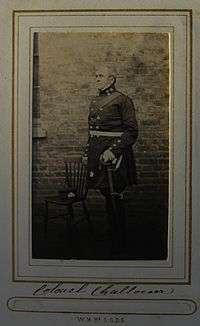
Military service
He served in the 1st Dragoon Guards (1809–1812).[Note 9]
County Offices
He was appointed a Justice of the Peace (J.P.) of Berkshire (1831) and of Surrey, and a Deputy Lieutenant (D.L.) for Surrey. He became High Sheriff of Surrey in 1838.
Parliamentary candidate
He stood for the West Surrey constituency in the 1852 general election but lost with 1385 votes to Evelyn (with 1646 votes) and Henry Drummond (1610 votes) elected as Conservatives.[12]
Royal Regiment of Surrey Local Militia
He became Lt. Colonel and commandant of the third Royal Regiment of Surrey Local Militia (No.118) from 26 March 1853 to 2 November 1867, when he became an honorary colonel. Its headquarters were at Croydon and then Kingston upon Thames.
Royal Agricultural Society of England
He was a member of the council and trustee of the Royal Agricultural Society of England from c. 1839–. He was chairman of the Finance Committee, Vice-chairman of the General Derby Committee,[13] and wrote several papers which appeared in the society journal. Papers included, Practical instructions for improving and economically maintaining turnpike and parish roads upon the mile system, volume 2, 1841; Report on the Exhibition and Trial of Implements at the Exeter Meeting, volume 11, 1850; and On the Accurate Levelling of Drains, volume 11, 1850.
Bagshot and Bedfont Turnpike Trust
He was chairman of the Bagshot and Bedfont Turnpike Trust, covering part of the road from London to Salisbury and Southampton and later on its subdivision trustee of its 'Western District' Turnpike.[14] He became Trustee of United Roads; of the Hampton to Staines Turnpike Trust; and a commissioner for the Surrey bank part of Staines Bridge from 1836 to 1871.
Seat and residences
.jpg)

Potnalls, Potenall, or Portnall Park, Virginia Water (then a pre-village within Egham's boundaries) was built c. 1770. In 1804, Thomas' father had it after exchange of land at Tite Hill, Egham (possibly land that had belonged to his maternal great-aunt Lydia Challoner) with David Jebb, the brother of John Jebb, FRS, then extended or re-built Portnall Park House. His son in turn extended it after 1828.
In 1872 Portnall was staffed by three men in the house; two in the stables; six or seven in the garden; nine or 10 maids; and four or five men on the farm, which encompassed, including rented land, 600 acres (2.4 km2).[15]
When sold to golf course pioneer and property developer Walter George Tarrant to form the core of the Wentworth Estate and Golf Course, Virginia Water for £15,000 in 1923, the mansion and estate comprised 196 acres (0.79 km2) with a 2,400 feet (0.73 km) frontage to the main road (the A30). The house had 27 or 30 bedrooms and dressing rooms. There was a 'large square block of stabling' (for 15 horses); a six-booth coach house; barn; cowsheds; bailiff's cottage; bothy; potting sheds; 'good' greenhouses; two walled gardens; five pairs of freehold cottages (three at Shrubs Hill and two at Knowle Hill); two lodge cottages; and a gardener's cottage.
From the 1830s through 1841 Col. Challoner was resident at 29 Portman Square. In January 1842, Boyle's Court Guide listed him at 169 New Bond Street (The Clarendon Hotel), and from 1843 until death at 11 Charles Street, Mayfair.
He had two renters' shares in Drury Lane Theatre and was a member of Brooks's (and the Garrick Club as an original member).
Arms

- 14 January 1829 : Challoner was authorised by Royal Licence/warrant to assume the name of Challoner 'in addition after Bisse'.
- 28 December 1831 : he was granted the arms of Bisse (he was unsuccessful in trying to prove kin with the Bisse of Croscombe and Spargrove, Somerset)
- 24 January 1832 : he was granted the arms of Challoner and Bisse.
- Bisse-Challoner arms:
- Sable on a pale argent three escallops of the field and for the crest on a wreath of the colours on a mount vert two serpents entwined respecting each other proper the heads encircling an escallop inverted or
- On a wreath of the colours out waves a demi-sea-wolf issuant proper holding between the fins a cross patée sble and the crest of Bisse as the same as in the margin here of more plainly depicted'
- Sable on a chevron cottised between three cherubins Or as many crosses patées fichés of the field for Challoner'
- Tottenham arms:
- Gules three bars dancettée argent
Gallery
Family portraits
%2C_wife_of_Thomas_Aynscombe_(1706).jpg) Jane Stebbing, wife to Thomas Aynscombe, painted c 1706. A grandmother-in-law of Bisse-Challoner's uncle Lilly Smith Aynscombe. Another portrait that he inherited and hung at Portnall.
Jane Stebbing, wife to Thomas Aynscombe, painted c 1706. A grandmother-in-law of Bisse-Challoner's uncle Lilly Smith Aynscombe. Another portrait that he inherited and hung at Portnall._by_James_Maubert.jpg) The five eldest (right to left) children of Robert Smith (c.1718), by James Maubert (1666–1746). (Oil on canvas, 62 × 69 inches.) Bisse-Challoner's grandmother, Anne Townsend, is second from right in blue. Once hung at Portnall.
The five eldest (right to left) children of Robert Smith (c.1718), by James Maubert (1666–1746). (Oil on canvas, 62 × 69 inches.) Bisse-Challoner's grandmother, Anne Townsend, is second from right in blue. Once hung at Portnall.%2C_attributed_to_Gainsborough_Dupont.jpg) Miss or Mrs Townsend, attributed to Gainsborough Dupont. Bisse-Challoner's mother or an aunt. Sold by Christie's in 1931 as Mrs. Townsend, misattributed to Thomas Gainsborough, RA.
Miss or Mrs Townsend, attributed to Gainsborough Dupont. Bisse-Challoner's mother or an aunt. Sold by Christie's in 1931 as Mrs. Townsend, misattributed to Thomas Gainsborough, RA._by_Henry_Richard_Graves.jpg) Challoner's greatnephew-in-law Lawrence Challoner Garratt (1868–1946), OBE, JP, of Bishops Court, Sowton, Devon, by Hon. Henry Richard Graves (1818–1882), (dated 1874, oil on canvas, 56 × 40 inches).
Challoner's greatnephew-in-law Lawrence Challoner Garratt (1868–1946), OBE, JP, of Bishops Court, Sowton, Devon, by Hon. Henry Richard Graves (1818–1882), (dated 1874, oil on canvas, 56 × 40 inches)._by_Gainsborough_Dupont.jpg) Bisse-Challoner's uncle William Townshend of Fulham (1741–1823) by Gainsborough Dupont (1754–1797). (The picture was in Challoner's collection. In 1931 his heir sold it at Christie's. It passed to Atlanta's High Museum of Art and then to Gainsborough's House, Sudbury, Suffolk).
Bisse-Challoner's uncle William Townshend of Fulham (1741–1823) by Gainsborough Dupont (1754–1797). (The picture was in Challoner's collection. In 1931 his heir sold it at Christie's. It passed to Atlanta's High Museum of Art and then to Gainsborough's House, Sudbury, Suffolk)._by_Joshua_Reynolds_or_a_follower.jpg) An 18th-century oil on canvas portrait of Lillie Smith Aynscombe (c. 1715–1791), by Joshua Reynolds or one of his followers. The picture was in Challoner's collection.[16]
An 18th-century oil on canvas portrait of Lillie Smith Aynscombe (c. 1715–1791), by Joshua Reynolds or one of his followers. The picture was in Challoner's collection.[16].jpg) Portrait of hitherto unidentified members of Bisse-Challoner's family by Arthur Devis (1712–87).
Portrait of hitherto unidentified members of Bisse-Challoner's family by Arthur Devis (1712–87)..jpg) The Love Song, 1749, by Arthur Devis, showing two members of Challoner, Aynscombe, Smith, Bisse, or associated family. Possibly Lydia Smith (1714-1803) or her brother Lillie Anscombe and his wife Valentina. Part of the Portnall Park collection.[7]
The Love Song, 1749, by Arthur Devis, showing two members of Challoner, Aynscombe, Smith, Bisse, or associated family. Possibly Lydia Smith (1714-1803) or her brother Lillie Anscombe and his wife Valentina. Part of the Portnall Park collection.[7].jpg) Henrietta Emma Helena De Salis (second wife). (1824-1863). A pastel taken before their marriage.
Henrietta Emma Helena De Salis (second wife). (1824-1863). A pastel taken before their marriage..jpg) Carte de visite, of Henrietta Emma Helena De Salis. Possibly by Camille Silvy.
Carte de visite, of Henrietta Emma Helena De Salis. Possibly by Camille Silvy.%2C_standing.jpg) Henrietta Emma Helena De Salis.
Henrietta Emma Helena De Salis._by_Spiridone_Giambardella.jpg) A posthumous portrait of Henrietta Emma Helena De Salis by Gambardella.
A posthumous portrait of Henrietta Emma Helena De Salis by Gambardella._in_All_Saints%2C_Fulham.jpg) Monumental inscription to Chaloner Bisse-Challoner's aunt Mary Barnard (c1753-1842), that he had put up in All Saints Church, Fulham.
Monumental inscription to Chaloner Bisse-Challoner's aunt Mary Barnard (c1753-1842), that he had put up in All Saints Church, Fulham.
Buildings
_by_George_Frederick_Prosser.jpg) Portnall in 1828, a print by George Prosser. Rev. Thomas Bisse extended or re-built the mansion. His son in turn extended it after 1828.
Portnall in 1828, a print by George Prosser. Rev. Thomas Bisse extended or re-built the mansion. His son in turn extended it after 1828.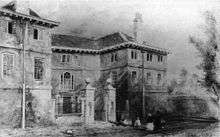 Cromwell House, Mortlake. The Aynscombe family home to 1841.
Cromwell House, Mortlake. The Aynscombe family home to 1841..jpg) Chew's House, from Charles Lambourn's Dunstaplelogia, 1859. Thomas Aynscombe, Frances Ashton and Jane Cart endowed the Chew's Foundation, Dunstable, which opened in 1724. The school house still stands and records their names on its front.
Chew's House, from Charles Lambourn's Dunstaplelogia, 1859. Thomas Aynscombe, Frances Ashton and Jane Cart endowed the Chew's Foundation, Dunstable, which opened in 1724. The school house still stands and records their names on its front..jpg) A distant prospect of the post-1773 St. Leonard's Hill. From Jones's Views of Seats, 1829. Lillie Smith Aynscombe rebuilt the Hermitage, Clewer, Windsor, and lived there from 1750 to 1773 when he sold it to the Duke of Gloucester who renamed it Sophia Farm. The site formed part of the Windsor Safari Park and today is within Legoland.
A distant prospect of the post-1773 St. Leonard's Hill. From Jones's Views of Seats, 1829. Lillie Smith Aynscombe rebuilt the Hermitage, Clewer, Windsor, and lived there from 1750 to 1773 when he sold it to the Duke of Gloucester who renamed it Sophia Farm. The site formed part of the Windsor Safari Park and today is within Legoland. Challoner's house in Charles Street, as it was in 2009.
Challoner's house in Charles Street, as it was in 2009.
Art
.jpg) Mount Vesuvius erupting in 1812, as seen from the Ponte della Maddalena. A Neapolitan gouache, one of Challoner's souvenirs of Naples. He and his wife lived in Naples c. 1815–1828.
Mount Vesuvius erupting in 1812, as seen from the Ponte della Maddalena. A Neapolitan gouache, one of Challoner's souvenirs of Naples. He and his wife lived in Naples c. 1815–1828..jpg) A Neapolitan gouache, detail of Vedia dei Golfo di Pozzuoli, once in collection of Col. Challoner
A Neapolitan gouache, detail of Vedia dei Golfo di Pozzuoli, once in collection of Col. Challoner Bisse-Challoner menu card, c. 1830s.
Bisse-Challoner menu card, c. 1830s.%2C_ex-Aynscombe_of_Mortlake_collection_(colour_repro).jpg) The Falls of Reichenbach, pencil and watercolour, by John Robert Cozens (1752–97), (14.6 x 9.5 inches), inherited, probably, from one of his Miss Aynscombe, of Mortlake, cousins.
The Falls of Reichenbach, pencil and watercolour, by John Robert Cozens (1752–97), (14.6 x 9.5 inches), inherited, probably, from one of his Miss Aynscombe, of Mortlake, cousins.
Heraldry and Arms and silver
 Bisse arms as granted to Col. Challoner, 28 December 1831.
Bisse arms as granted to Col. Challoner, 28 December 1831. Arms of Bisse and Challoner, quartered, granted 24 January 1832. Made for Col. Challoner.
Arms of Bisse and Challoner, quartered, granted 24 January 1832. Made for Col. Challoner. Bisse-Challoner crests on back of a Portnall hall chair.
Bisse-Challoner crests on back of a Portnall hall chair..jpg) From Burke's Landed Gentry, 1863, Challoner's entry.
From Burke's Landed Gentry, 1863, Challoner's entry. Detail of a tea-pot with crests of Bisse-Challoner
Detail of a tea-pot with crests of Bisse-Challoner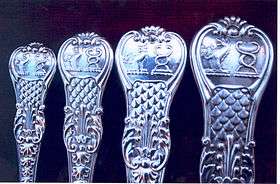 Coburg pattern fork and spoon ends by William Eaton (London, 1830/31) that bear the cast crests of Bisse and Challoner
Coburg pattern fork and spoon ends by William Eaton (London, 1830/31) that bear the cast crests of Bisse and Challoner Part of a canteen of Coburg pattern plate made for Challoner c1831
Part of a canteen of Coburg pattern plate made for Challoner c1831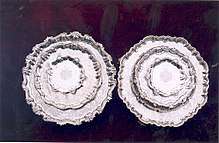 Seven Georgian salvers (1732-John Tuite; 1736-Robert Abercrombie; 1740-James Schruder; 1745-William Peaston; 1747-Peter Taylor; and 1750-Henry Morris (pair)). With the arms of Bisse impaling Tottenham added c.1812, with crests of Challoner and Bisse.
Seven Georgian salvers (1732-John Tuite; 1736-Robert Abercrombie; 1740-James Schruder; 1745-William Peaston; 1747-Peter Taylor; and 1750-Henry Morris (pair)). With the arms of Bisse impaling Tottenham added c.1812, with crests of Challoner and Bisse.
Notes and references
Notes
- Other names: Colonel Thomas Chaloner Bisse-Challoner; Chaloner Bisse Challoner; Colonel C. B. Challoner; T.-C. Bisse-Challoner; Mr Bisse Challoner; Colonel Bisse Challoner (by 1828); Thomas Challoner Bisse; Thomas Bisse; my nephew Chaloner.
- He enrolled at Trinity College, Oxford on 26 March 1806, aged 17.
- William Smith was under 21 in 1747 and appears from his lack of more major inheritance to have died young.
- Blackhorse Yard, Holborn – was formerly the Three horseshoe brewhouse yard
- 246 and 247 High Street, Borough, Southwark was inherited from his first-cousin, Valentina Aynscombe (d.1841)
- 86 shares in Sun Fire Office worth £17,200 in 1872
- 54 shares in Sun Life Office inherited, indirectly, from his maternal-great-grandfather Robert Smith (d.1748)
- 9,000 preference shares in the Trent & Mersey Canal and the North Staffordshire Railway inherited from his maternal-great-aunt, Lydia Challoner (d.1803), (a 1% holding worth £20,250 in 1872)
- He served in the King's Dragoon Guards – Cornet: 9 March 1809; lieutenant: 1 August 1811.
References
- At least 200 acres was owned outright and passed to the succeeding two next generations, the rest seems to have been rented during his lifetime.
- Matriculation date
- Prerogative Court of Canterbury PROB 11/916/349
- Painting of William Townsend
- Monumental inscription in All Saints, Fulham
- Image of Lydia Archived 19 December 2014 at the Wayback Machine Staffs Past Track. Retrieved 2014-12-19.
- Love Song, Duet Arts Council. Retrieved 2014-12-19.
- 20 Geo. II, c. 7
- GM
- Prerogative Court of Canterbury
- The London Gazette, Friday, 23 January 1829, no. 18543
- West Surrey constituency seat had a population of 102,856, of which 3,897 people were registered electors
- The Farmer's Magazine, London, 1839
- Documents of Horne Engall and Freeman Solicitors Records at the London Metropolitan Archives. Page 486 and others. Retrieved 2014-12-19.
- (De Salis, 1939)
- Art Prices Current, vol. 11, 1933, no. 1580
Other Sources
- Select Illustrations of the County of Surrey: Comprising picturesque Views of the Seats of the Nobility and Gentry. Interesting remains, and with Descriptions ... , by George Frederick Prosser, and published by Rivington, London, 1828.
- R. de Salis, Beneficiary Bisse : Colonel Chaloner Bisse-Challoner, heir and his heirs. London, 2008.
- Edith Mary Johnston-Liik, History of the Irish Parliament 1692–1800, p. 422-3, volume six of six, 2002 (re. Tottenham family).
- Alumni Oxonienses: 1715–1886, vol. 1, by Joseph Foster, James Parker & Co., London, 1891.
- The Parliamentary Companion, for 1854, Charles R. Dod, London, Whittaker & Co., 1854.
- Two scrolls from the College of Arms, and a schedule of Col. Challoner's estate in 1872.
- Boyle's Fashionable Court and Country Guide, 1842, &tc, edited by M. Boyle, 290 Regent Street (five shillings), London.
- Musgrave's Obituary, Harlean Society no. 44, six volumes, 1899–1901 (Sir William Musgrave, Bart.)
- Rachel and Cecil de Salis, Notes of Past Days, Henley-on-Thames, 1939 (chapter 3, My Uncle Challoner, pps. 121–126).
- R. G. Thorne, History of Parliament, The Commons 1790–1820, Secker & Warburg, 1986.
- Walford's County Families, 1865.
- The Mayors of Norwich 1403 to 1835, by Basil Cozens-Hardy, FSA and Ernest A. Kent, FSA, Jarrold and sons, Ltd, Norwich, 1938. (a note on Phillip Stebbing, page 101).
- Seventeenth-Century Norwich, Politics, Religion and Government, 1620–1690, John T. Evans, Oxford, 1979.
- Percy Millican, The Register of The Freeman of Norwich, 1548–1713, Jarrold, Norwich, 1934.
- Reports of Cases Argued and Determined in the High Court of Chancery: In the Time of Lord Chancellor Hardwicke [1736–1754], by John Tracy Atkyns, Philip Yorke Hardwicke, Great Britain Court of Chancery, William Newnam, Great Britain, Court of Chancery, Printed for J. Wenman, Oxford, 1781. (Frederick v Aynscombe, 1739).
- Peter G. M. Dickson, The Sun Insurance Office, 1710–1960, Oxford, 1960.
- Kim Sloan, 'A New Chronology for Alexander Cozens part II: 1759–86', The Burlington Magazine, Volume 127, No. 987 (June 1985), pp. 355–363.
- Christie's London, British drawings sale, 15 June 1982, lots 5 – 10 (works associated with Charlotte Aynscombe (1760–1799)).
- L.C.C., Survey of London, volume 22, Bankside, Sir H. Roberts & Walter Godfrey (editors), 1950.
- Topographical Dictionary, London and its Environs, etc., by James Elmes, M.R.I.A., Architect; Surveyor to the Port of London; London. Whittaker, Treacher and Arnot, MDCCCXXXI (1831).
- Sermons on Practical Subjects, by the late Reverend Henry Stebbing [d.1788], D.D., preacher to the Hon. Society of Gray's Inn, Chaplain in Ordinary to His Majesty, and Fellow of the Royal and Antiquarian Societies, London, with an essay by Henry Stebbing [1752–1818], printed for C. Dilly, in the Poultry, 1788.
- The Lady Magazine, 1831. (Mr & Mrs Bisse Challoner were presented to the Queen at her birthday ball at Christ's Hospital.
- The Registers of Wadham College, Oxford, part 1, 1613–1719, by Rev. Robert Barlow Gardiner, MA, FSA, George Bell, Covent Garden, 1889.
- The Registers of Wadham College, Oxford, part 2, 1719–1871, by Rev. Robert Barlow Gardiner, MA, FSA, George Bell, Covent Garden, 1895.
- Prerogative Court of Canterbury (P.C.C.) wills for, amongst others: Daniel Wight (1705); Elizabeth Aynscombe (1713); Philip Stebbing (1715); Jane Elliott (1718); Thomas Aynscombe (1740); Robert Smith (1748); George Challoner (1770); Charlotte Anne Aynscombe (1799); Lydia Challoner (1803); Rev. Thomas Bisse (1828); Valentina Aynscombe (1841); and Mary Barnard (1842). (Available on-line from P.R.O. Kew, aka National Archives).
- The Virginia Water Picture Book by Ron and Dorothy Davis, Egham-by-Runnymede Historical Society, Surrey, 1989.
| Honorary titles | ||
|---|---|---|
| Preceded by Thomas Alcock |
High Sheriff of Surrey 1838 |
Succeeded by Samuel Paynter |